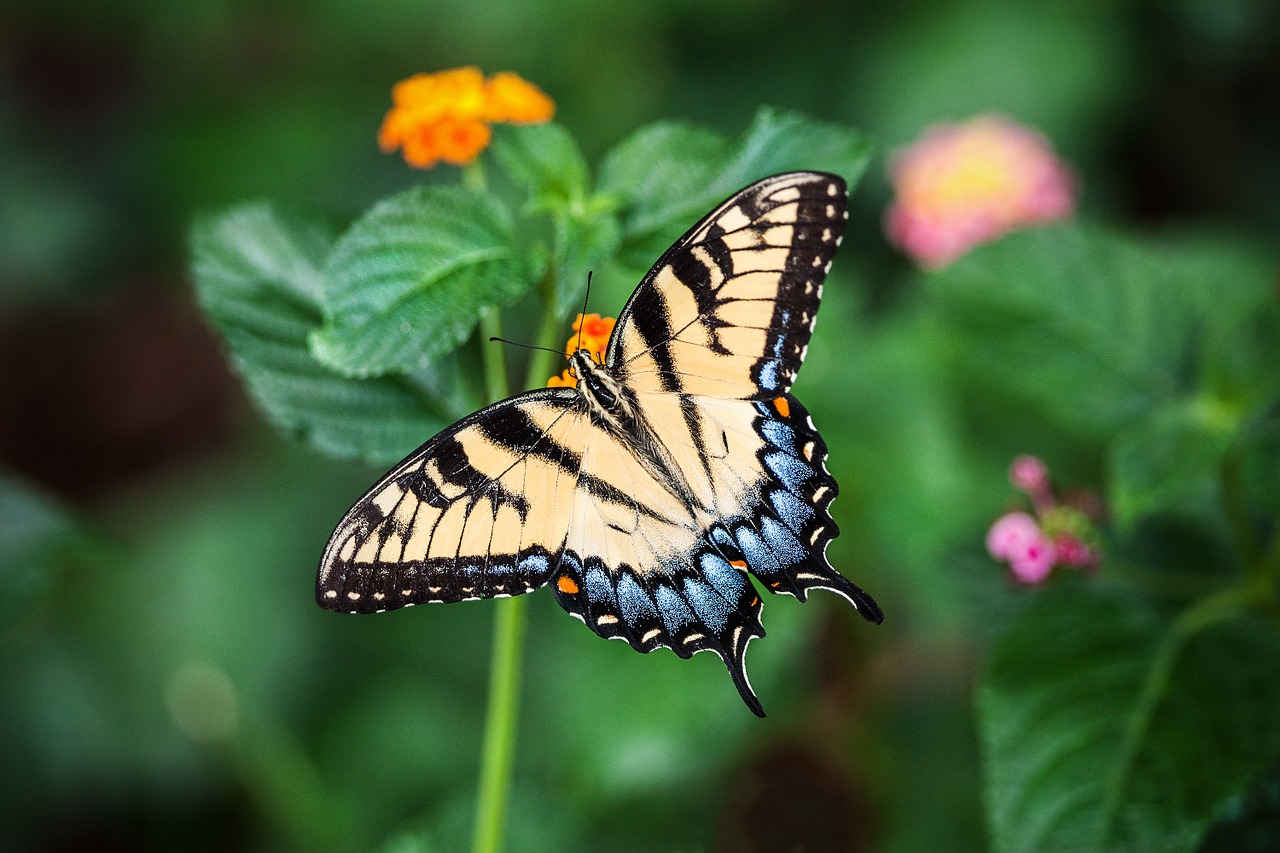Mindfulness in Nature: Why Local Pollinators Are Important
I met Jill Jacobs at a press event a few weeks ago and was so inspired by her passion for pollinators and plants. I had to know more for myself and share it with y’all!
Now that it’s officially spring, I’m starting to see bees and butterflies and wildflowers during yoga hikes here in Western North Carolina and most of us know how important they are to the health of both wild plants and cultivated crops. But did you know that not all bees live in hives and that moths, hoverflies and wasps are important pollinators too? You’ll also learn how to help these important insects thrive whether spotting them on the trail or trying to attract them to your garden.
Brannen Basham and his wife Jill Jacobs are co-owners of Spriggly’s Beescaping, a nature education business dedicated to increasing environmental awareness. Spriggly’s Beescaping offers interactive exhibits, workshops, garden installations, nature writing, and more. With a special focus on the 4,000+ species of native bees in North America, Spriggly's works to increase appreciation for beneficial insects, habitat restoration, and the wonderful world around us.
Enjoy this informative post and beautiful pictures by Jill and Brannen.
Namaste & Have A Great Day!
Miranda
As one of the oldest mountain ranges in the world, the Appalachian Mountains are home to an extraordinarily dense amount of native flora and fauna, including thousands of species of beneficial insects. The insects in the landscapes around you are all tirelessly performing a wide variety of important tasks, including pest control and pollination.
While you are out and about exploring this year, make sure to take a look for the many different species of native pollinators in the Appalachian Mountains. Although there are more than five types of pollinators in this region, let’s take a look at the top five commonly seen in and around the area and the types of native habitat needed to support them.
Native Bees: Nature’s Pollination Machines
There are over 4,000 species of bees native to North America alone. This does not include honey bees, who were brought here by European explorers in the 1600s. The vast majority of bees are solitary, which means they do not live cooperatively in a hive. Each solitary female provisions her young with a ball of pollen and nectar and seals them off into a protected room so that they can grow in peace. For example mason bees, who nest in holes dug by beetle larvae in dead wood, create walls of mud and tiny bits of rock.
Most of the native bees in the Appalachian mountains live in the ground, where they dig tunnel apartments in order to make their nests. Because they don’t share a large hive with other bees, solitary bees do not have the same defensive instincts that other social insects do. This makes them very docile and fun to watch. There are several species of bees native to the states that do live together. Bumble bees are our most commonly seen social native bee, however they are also very laid back and unlikely to sting unless they are attacked.
Keep your eye out for these gentle flyers as you hike along the Appalachians this season, and watch your step! There’s a good chance that small hole in the ground is the humble home of a local solitary bee. Leaving areas of bare soil in a landscape can give ground nesting native bees a good place to settle down, and allowing fallen trees and limbs to stay where they are can help wood nesting bees as well.
Bumble Bee
Hoverflies: Pollinator Dopplegangers
Bees are some of the most popular flower visitors, however they also take the credit for the pollination work of other insects as well. This is because many flies can easily be mistaken as bees at a first glance. Some species of flies have decided that the best defense is mimicry, and they can resemble bees, wasps, and other undesirable prey to a remarkable degree.
Even though they are poor pollinators individually, there are normally more flies than bees around garden blooms by far, and by the sheer number of flies visiting flowers for drinks they are believed to be second only to bees in their pollination services. Bee-themed hoverflies are commonly seen lounging around flowers, however they are not only looking for a floral drink. When a female hoverfly smells a large congregation of aphids, she lays groups of eggs near the growing pest convention. After they hatch, these young hoverflies consume a huge amount of aphids, in turn helping these flowers survive another day.
Hoverfly
Moths: Evening Wanderers
Moths pick up the slack in pollination during the dark and cold of the night, and are the main pollinators for plants that prefer to bloom in such an environment. There are actually far more species of moths than there are butterflies, which can be difficult to tell based on their extremely effective camouflage that they use in order to hide during the day. After nightfall, these fuzzy gliders rely on chemical signals in order to find each other. Studies have recently shown that these signals, called pheromones, actually emit infrared light in order to most effectively lure in a lover. Some moths have been shown to navigate by the stars and moon in order to find their way during long migrations.
Moths’ reliance on extremely subtle lights in order to make their way around could be why they are so easily drawn to artificial light. Make sure to turn off any unnecessary outdoor lighting in order to make it easier for the moths in your area to pollinate your blooms. Many moth species prefer to raise their young on specific plants that they use to incorporate predator-deterring chemicals into their bodies. To support the native moths in your area, try and plant native plants whenever possible.
Luna Moth
Butterflies: Beautiful and Beneficial
Butterflies are known as secondary pollinators, due to the fact that the small amount of pollination they provide is mostly from the beating of their wings as they balance among flowers. This is because of their long tube-like tongues, which allow them to reach down into the nectar of a flower while they keep themselves as far from the messy pollen as possible.
Butterflies prefer to keep their wings clean as they drink, as they use their wings as a multi-tool of sorts. Butterflies rely on their wings in order to attract mates, confuse predators, and escape danger. They do so by covering their wings in millions of microscopic scales, which are made of a unique crystalline structure designed to absorb or reflect specific colors. These scales are also engineered to easily break off in the event of an attack, hopefully leaving any hungry predator with a mouth full of scales while the butterfly flies away in victory.
Butterflies prefer wide, easily accessible flowers that they can drink from without coming too close. Compound flowers like Queen Anne’s Lace and those in the carrot family are great examples of butterfly blooms. Like moths, many butterflies prefer to raise their young on specific plants, such as the spicebush and the aptly named spicebush swallowtail. Make sure to include native plants in your garden in order to cater to the greatest variety of butterflies in your area.
Tiger Swallowtail
Wasps: A Garden’s Best Defense
Wasps are mostly known for being garden predators, and they are good at what they do. It is believed that wasps account for over 50% of all insect-on-insect predation, and if it weren’t for wasps the world would be quickly overrun by all manner of insects. Even though they are the premier garden patrollers, you may be surprised to learn that wasps are important pollinators as well. Wasps feed on nectar in their adult form, and their constant trips to flowers for this natural energy drink ensures that they pollinate some plants simply by being there.
Like bees, the majority of wasps are solitary and live alone with little or no reason to ever bother or even come into contact with humans. While social species like paper wasps and yellow jackets can be ornery and give wasps a bad name, most wasps don’t even possess a stinger to use in self defense. Instead, many inject eggs directly onto or inside their prey using special tubes called ovipositors.
All wasps are surprisingly docile, and even social wasps can be easily observed as long as you are away from their nest. Wasps enjoy the same easily accessible types of flowers that butterflies do, and they appreciate pest populations in a garden that they can use to feed their young. By allowing pests like caterpillar, aphids, and other grazers to build up populations, it is often times possible to attract wasp pest control that is far more effective than any chemical application.
Mud Dauber Wasp
Planting for Pollinators
Planting for pollinators is easy to do as long as you follow a few simple rules.
First off, take a look at the plants already around you and when they are in bloom. The pollinators in your area are already relying on these plants for food and shelter, so try and compliment them in your plantings. It is ideal to have something in bloom in your area at all times during the growing season, so fill in any bloom gaps that you find in the plants around you. Plant your flowering plants in groups of at least three feet around, so that they are large and easy to see or smell by any wandering pollinators.
If you have any favorite species that you would like to attract, make sure to research if they have any specific plants in mind when they look for a place to settle down. This is especially true when trying to attract butterflies and moths.
Last but not least, stop using pesticides. Many insecticides, herbicides, and even fungicides have been found to negatively affect the pollinators that your plants depend on in order to properly reproduce. Many garden problems can be effectively solved by methods other than those found at the bottom of a bottle.
How Does Pollination & Floral Attraction Work?
Learn more about Bee Cabins, Pollinator Gardens, Events & Workshops at sprigglys.com and follow them on Instagram and Facebook @sprigglys_beescaping!









